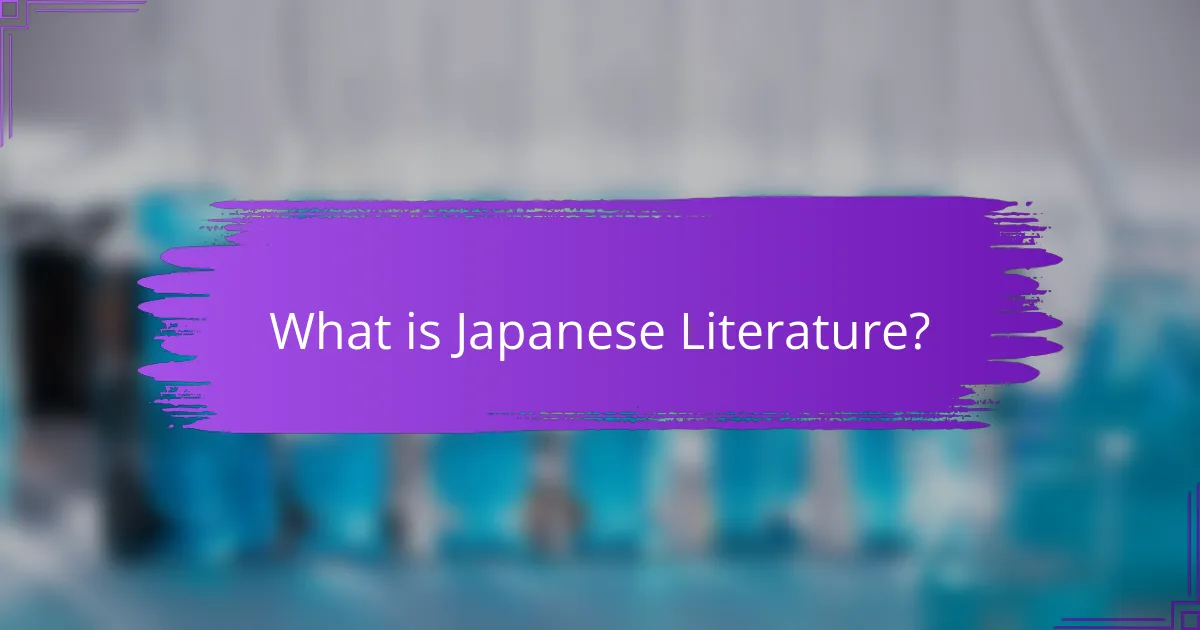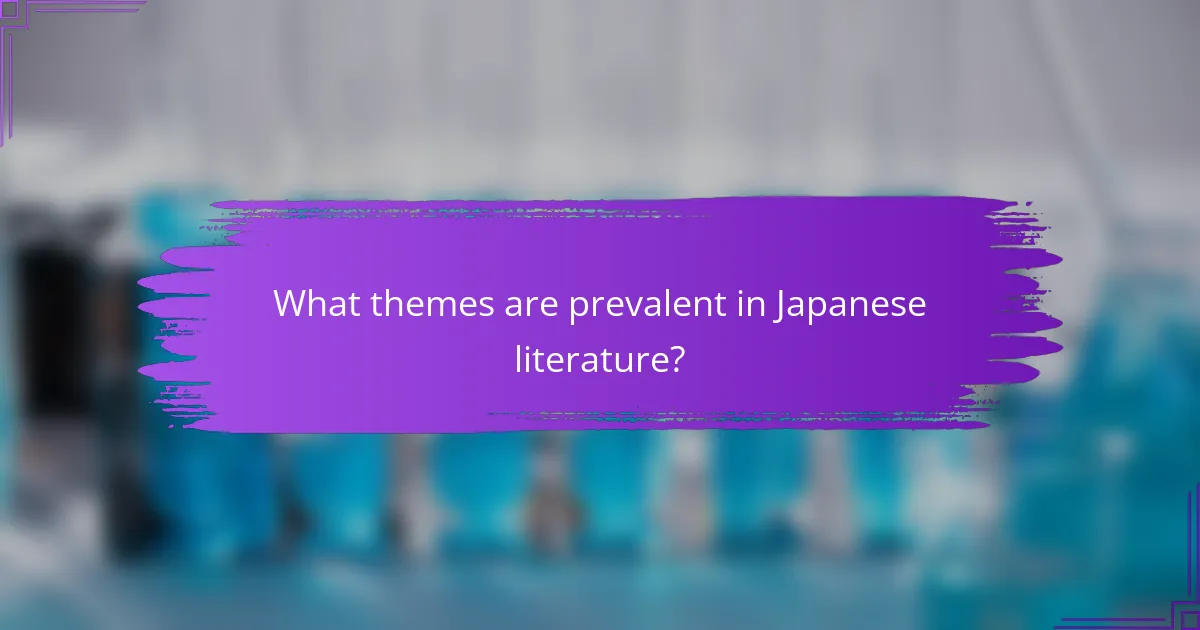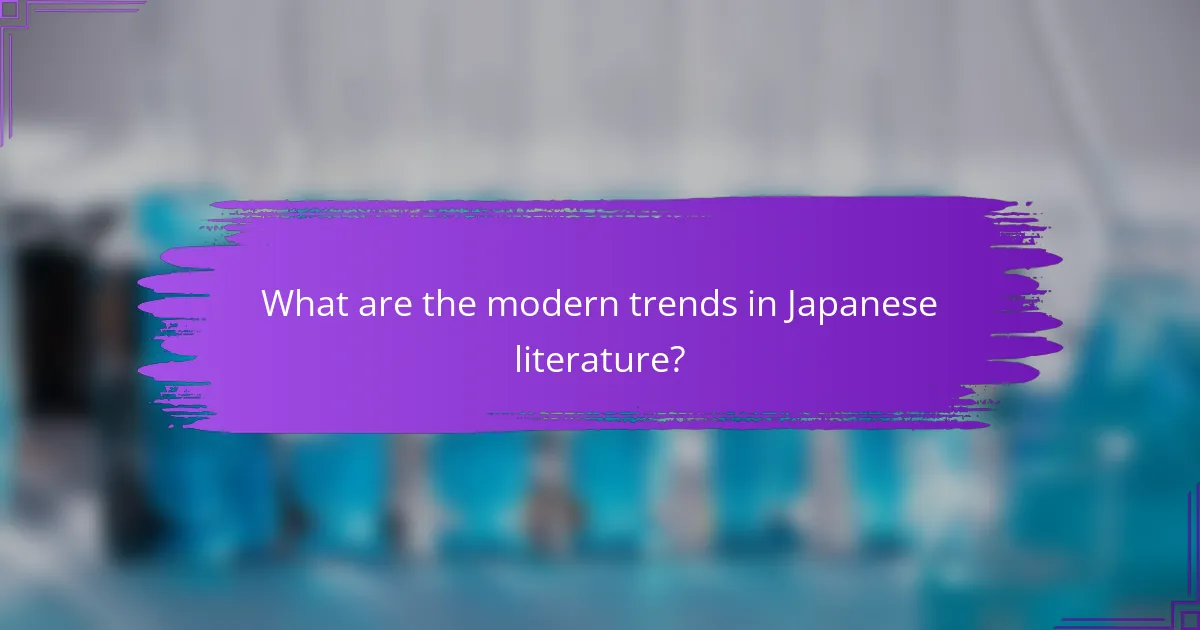
What is Japanese Literature?
Japanese literature encompasses the written works produced in Japan, reflecting its culture and history. It includes poetry, novels, essays, and plays. Key periods include classical literature from the Heian era and modern literature from the Meiji era onward. Notable authors include Murasaki Shikibu, Yukio Mishima, and Haruki Murakami. Themes often explore nature, identity, and societal issues. Japanese literature has influenced global literature and continues to evolve today. Its rich tradition showcases a unique blend of aesthetics and philosophical thought.
How has Japanese literature evolved over time?
Japanese literature has evolved significantly from ancient times to the modern era. It began with oral traditions and early texts like “The Tale of Genji,” written in the early 11th century. This work is often considered the world’s first novel. The Edo period saw the rise of popular genres such as ukiyo-e and kabuki, reflecting societal changes. In the late 19th century, Western influences introduced new literary forms and themes. Authors like Natsume Sōseki and Mori Ōgai emerged during this time. The post-war era brought a focus on existential themes, with writers like Yukio Mishima gaining prominence. Contemporary Japanese literature continues to explore identity and culture, showcasing diverse voices and styles. The evolution reflects Japan’s historical, social, and cultural transformations throughout the centuries.
What are the major historical periods in Japanese literature?
The major historical periods in Japanese literature include the Nara period, Heian period, Kamakura period, Muromachi period, Edo period, Meiji period, Taisho period, and Showa period. Each period is characterized by distinct literary styles and themes.
The Nara period (710-794) saw the emergence of early Japanese poetry and historical chronicles. The Heian period (794-1185) is known for its court literature, including “The Tale of Genji.” The Kamakura period (1185-1333) introduced warrior tales and Buddhist literature.
The Muromachi period (1336-1573) featured Noh drama and the rise of Zen-influenced poetry. The Edo period (1603-1868) was marked by the popularity of ukiyo-e and the development of the novel. The Meiji period (1868-1912) brought Western influences and modernization in literature.
The Taisho period (1912-1926) is recognized for its experimentation and the rise of modernist literature. Finally, the Showa period (1926-1989) included diverse literary movements and responses to social change. Each of these periods contributed significantly to the evolution of Japanese literature.
How have cultural shifts influenced Japanese literary styles?
Cultural shifts have significantly influenced Japanese literary styles throughout history. The Meiji Restoration in the late 19th century marked a transition from traditional to modern literature. This period saw the introduction of Western literary forms and ideas. Authors like Natsume Sōseki began to experiment with new narrative techniques. Post-World War II literature reflected the trauma and societal changes of the era. Writers like Yukio Mishima explored themes of identity and existentialism. The rise of popular culture in the late 20th century also shaped literary expression. Manga and light novels emerged as new forms of storytelling. Each cultural shift has redefined the boundaries of Japanese literature.
What are the defining characteristics of Japanese literature?
Japanese literature is characterized by its deep connection to nature, [censured], and the exploration of human emotions. Themes often include the transience of life, as seen in the concept of mono no aware, which reflects the beauty of impermanence. The use of imagery and symbolism is prevalent, drawing from traditional art forms. Narrative styles vary from poetic forms like haiku to prose in novels and short stories. Influential works often depict social issues, family dynamics, and personal struggles. Historical context plays a significant role in shaping the literature, particularly during periods like the Heian and Edo eras. Prominent authors, such as Matsuo Bashō and Haruki Murakami, showcase these characteristics through their unique styles and perspectives. Overall, Japanese literature offers a rich tapestry of cultural reflections and philosophical insights.
What themes are commonly explored in Japanese literary works?
Common themes in Japanese literary works include the exploration of nature, the concept of impermanence, and the complexities of human relationships. Nature often reflects characters’ emotions and serves as a backdrop for their experiences. The theme of impermanence, or “mono no aware,” emphasizes the beauty of fleeting moments. Human relationships are frequently depicted with depth, showcasing love, loss, and societal expectations. Additionally, themes of identity, tradition versus modernity, and existential contemplation are prevalent. These themes are rooted in Japan’s cultural and historical context, influencing literary expressions across various genres and periods.
How do literary forms and genres differ in Japanese literature?
Literary forms and genres in Japanese literature differ primarily in structure and thematic focus. Traditional forms include poetry, such as haiku and tanka, which emphasize brevity and nature. Prose genres, like novels and essays, explore complex narratives and character development. Additionally, Japanese literature features unique forms like Noh and Kabuki, which combine drama with performance. Each genre reflects cultural values and historical context. For instance, the Heian period’s “The Tale of Genji” showcases court life and romance, while modern works address contemporary issues. This diversity illustrates the richness of Japan’s literary landscape.
Who are the key authors in Japanese literature?
Key authors in Japanese literature include Murasaki Shikibu, Natsume Sōseki, and Yukio Mishima. Murasaki Shikibu is known for writing “The Tale of Genji,” often considered the world’s first novel. Natsume Sōseki is recognized for his works like “Kokoro” and “Botchan,” which explore themes of individualism and modernity. Yukio Mishima, a controversial figure, authored “The Temple of the Golden Pavilion” and “Confessions of a Mask,” delving into existential themes. Other notable authors include Haruki Murakami, known for blending magical realism with contemporary issues, and Banana Yoshimoto, who focuses on themes of love and loss. These authors significantly shaped Japanese literature through their unique perspectives and styles.
What contributions did classical authors make to Japanese literature?
Classical authors significantly shaped Japanese literature through their pioneering works and stylistic innovations. They introduced narrative forms, such as the monogatari, exemplified by “The Tale of Genji” by Murasaki Shikibu. This work is often regarded as the world’s first novel, blending poetry with prose.
Classical authors also advanced the use of kana, which allowed for a more expressive and accessible written form. This development democratized literature, enabling broader participation in literary culture. Furthermore, they explored themes of nature, love, and the impermanence of life, influencing subsequent literary movements.
Their contributions established foundational genres and motifs that remain prevalent in modern Japanese literature. The rich character development and psychological depth found in their works set a standard for future writers. Overall, classical authors laid the groundwork for the evolution of Japanese literature, influencing both form and content.
How have modern authors shaped contemporary Japanese literature?
Modern authors have significantly shaped contemporary Japanese literature through innovative storytelling and thematic exploration. They have introduced diverse narratives that reflect societal changes and cultural shifts. Notable figures like Haruki Murakami have blended magical realism with existential themes. Other authors, such as Banana Yoshimoto, focus on personal relationships and emotional depth. The rise of genres like light novels and manga has also transformed literary consumption. These authors often address issues like identity, technology, and globalization. Their works resonate with both national and international audiences, expanding the reach of Japanese literature. The impact of modern authors is evident in the evolving literary landscape and the emergence of new voices.

What themes are prevalent in Japanese literature?
Prevalent themes in Japanese literature include nature, the transient nature of life, and human emotions. Nature is often depicted as a powerful force that influences human experiences. The concept of “mono no aware” reflects the beauty of impermanence. This theme emphasizes the fleeting moments of beauty and sadness in life. Additionally, themes of isolation and the search for identity are common. Works often explore personal struggles against societal expectations. The influence of historical events also shapes literature, such as the impact of World War II. Themes of honor, loyalty, and family ties appear frequently in classical and modern works. These themes collectively reflect the complexities of Japanese culture and society.
How do historical events influence themes in Japanese literature?
Historical events significantly influence themes in Japanese literature. The literature often reflects societal changes, cultural shifts, and historical traumas. For example, the Meiji Restoration led to themes of modernization and identity in works like Natsume Sōseki’s “Kokoro.” The trauma of World War II resulted in existential themes in post-war literature, as seen in Yukio Mishima’s “The Temple of the Golden Pavilion.” Additionally, the Edo period’s isolation influenced the development of unique literary forms, such as ukiyo-e and kabuki plays. These historical contexts shape characters, narratives, and moral questions within the literature. The impact of events like the 2011 Tōhoku earthquake is also visible in contemporary works, highlighting resilience and disaster. Overall, Japanese literature serves as a mirror to the nation’s history, illustrating how events shape cultural expression.
What role does nature play in Japanese literary themes?
Nature plays a central role in Japanese literary themes. It often symbolizes beauty, transience, and the connection between humans and the environment. Many Japanese authors incorporate seasonal changes to reflect emotional states. For instance, cherry blossoms represent fleeting beauty and the impermanence of life. Nature also serves as a backdrop for exploring human experiences and relationships. Works like Matsuo Bashō’s haiku emphasize simplicity and harmony with nature. This connection reflects the cultural value placed on nature in Japan. The presence of natural elements often evokes nostalgia and contemplation. Overall, nature is intertwined with the essence of Japanese literature, influencing its themes and emotional depth.
How is the concept of identity explored in Japanese literature?
The concept of identity is explored in Japanese literature through themes of individualism, societal roles, and cultural heritage. Authors like Natsume Sōseki and Yukio Mishima delve into the complexities of self-perception. Sōseki’s “Kokoro” examines the inner turmoil of a young man grappling with his place in society. Mishima’s works often reflect the tension between modernity and traditional values. The exploration of identity is also evident in the works of contemporary authors like Haruki Murakami. His characters frequently experience existential crises and search for meaning. This literary focus mirrors Japan’s historical transitions, including the Meiji Restoration and post-war identity shifts. Overall, Japanese literature serves as a lens to understand the multifaceted nature of identity in a changing cultural landscape.
What cultural reflections can be found in Japanese literature?
Japanese literature reflects various aspects of Japanese culture, including social values, historical events, and philosophical beliefs. It often explores themes such as nature, impermanence, and the human condition. Classic works like “The Tale of Genji” highlight the importance of aesthetics and courtly life in Heian-era Japan. Modern literature frequently addresses the tension between tradition and modernity, as seen in the works of authors like Haruki Murakami. Additionally, literature often incorporates elements of Shinto and Buddhism, showcasing spiritual beliefs and practices. The portrayal of societal roles and family dynamics is also prevalent, reflecting the cultural importance of harmony and community. Overall, Japanese literature serves as a mirror to the evolving identity of Japanese society.
How does Japanese literature depict societal values and beliefs?
Japanese literature reflects societal values and beliefs through themes of harmony, duty, and nature. Works such as “The Tale of Genji” illustrate the importance of social hierarchy and personal relationships. Modern authors like Haruki Murakami explore existentialism and individualism, highlighting contemporary societal struggles. The portrayal of nature in poetry, such as haiku, emphasizes the Japanese cultural connection to the environment. Additionally, literature often critiques societal norms, as seen in works by Osamu Dazai. This duality showcases both adherence to and questioning of cultural values. Overall, Japanese literature serves as a mirror to the evolving beliefs within society.
What insights into Japanese culture can be gained from literary analysis?
Literary analysis of Japanese literature provides insights into societal values, historical context, and cultural norms. Themes such as honor, family, and nature frequently emerge, reflecting the importance of these concepts in Japanese society. Works like “The Tale of Genji” illustrate the complexities of court life and gender roles in historical Japan. Modern authors, such as Haruki Murakami, explore existential themes and urban life, showcasing contemporary cultural shifts. Furthermore, literary elements like symbolism and imagery reveal traditional beliefs and practices. For instance, the use of cherry blossoms often symbolizes the transient nature of life, a key aspect of Japanese philosophy. Overall, literary analysis serves as a lens to understand the evolution and intricacies of Japanese culture.

What are the modern trends in Japanese literature?
Modern trends in Japanese literature include a focus on diverse voices and genres. There is a notable rise in works by women authors. This trend reflects broader social changes in Japan. Additionally, contemporary themes often address issues like identity and globalization. The use of technology and digital platforms is also increasing. Many authors are exploring hybrid forms, blending genres and styles. Young writers are gaining recognition, often challenging traditional narratives. Overall, modern Japanese literature is characterized by its evolution and adaptability.
How is contemporary Japanese literature being received globally?
Contemporary Japanese literature is being received positively on a global scale. Many works have been translated into various languages, increasing accessibility. Authors like Haruki Murakami and Banana Yoshimoto have gained international acclaim. Their unique storytelling resonates with diverse audiences. Literary awards, such as the Akutagawa Prize, highlight the quality of Japanese literature. Global readership has expanded through online platforms and book clubs. Cultural themes in these works often bridge Eastern and Western perspectives. This cross-cultural exchange enriches the global literary landscape.
What are the emerging voices in modern Japanese literature?
Emerging voices in modern Japanese literature include authors like Sayaka Murata, Mieko Kawakami, and Hiroko Oyamada. Sayaka Murata gained recognition for her novel “Convenience Store Woman,” which explores societal expectations. Mieko Kawakami’s “Breasts and Eggs” addresses gender and identity issues in contemporary Japan. Hiroko Oyamada’s works, such as “The Factory,” delve into the surreal aspects of everyday life. These authors have been celebrated for their unique perspectives and innovative storytelling. Their contributions reflect shifting cultural narratives in Japan.
What practical tips can enhance the appreciation of Japanese literature?
Reading Japanese literature in translation can enhance appreciation. Translations by reputable scholars maintain the essence of original texts. Understanding cultural context enriches the reading experience. Familiarity with Japanese history and social norms provides deeper insights. Exploring various genres, such as haiku and modern novels, broadens perspectives. Engaging with literary criticism offers diverse interpretations and analyses. Participating in book clubs fosters discussion and shared insights. Attending lectures or workshops deepens understanding of thematic elements.
How can readers approach the themes and styles of Japanese literature?
Readers can approach the themes and styles of Japanese literature by understanding its cultural context. Japanese literature often reflects the nuances of Japanese society, history, and philosophy. Key themes include nature, impermanence, and the human condition.
Classic works like “The Tale of Genji” highlight the intricacies of court life and emotional depth. Modern authors such as Haruki Murakami explore existentialism and surrealism.
Familiarity with traditional forms, such as haiku and Noh theatre, enhances appreciation of stylistic elements. Engaging with literary criticism and historical analysis provides deeper insights into thematic development.
Reading translations alongside original texts can reveal linguistic subtleties and cultural references. Exploring diverse genres, from poetry to contemporary novels, showcases the breadth of Japanese literature.
What resources are available for exploring Japanese literary works?
Resources available for exploring Japanese literary works include libraries, online databases, and academic journals. Major libraries often have extensive collections of Japanese literature in translation. Online databases like JSTOR and Project MUSE provide access to scholarly articles on Japanese authors and themes. Additionally, universities with Japanese studies programs offer courses and resources for deeper understanding. Websites like the Japan Foundation and the National Diet Library also provide valuable information and access to literary works. These resources facilitate research and enhance appreciation of Japanese literature.
Japanese literature encompasses the written works produced in Japan, reflecting its rich culture and history through various forms such as poetry, novels, essays, and plays. The article explores the evolution of Japanese literature across key historical periods, highlighting major authors like Murasaki Shikibu, Natsume Sōseki, and Haruki Murakami, as well as prevalent themes including nature, identity, and societal issues. It discusses the impact of cultural shifts on literary styles and the defining characteristics that shape this body of work. Additionally, the article examines modern trends, emerging voices, and the global reception of contemporary Japanese literature, providing a comprehensive overview of its significance and ongoing evolution.